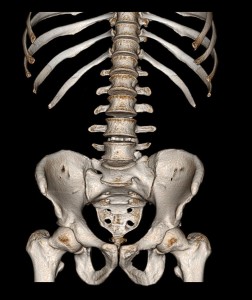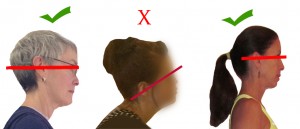Posture Tips: Sitting
In our culture it is common to sit with the pelvis tucked and the weight back near the tailbone. This forces the lower back into a rounded position and puts a lot of pressure on the discs and the nerve roots. If you try to sit up straight with a tucked pelvis it will cause discomfort and fatigue in your lower back, making it impossible to maintain that position for more than a few minutes. A well placed pelvis is the foundation of a properly stacked spine.
To the right is a front and side view of the pelvis. Notice the two round sitz bones at the bottom. They are sturdy and can easily take the weight of the torso. The tail bone is very small and fragile in comparison. With your weight in the middle of your sitz bones you will be able to maintain a comfortable position that does not stress the lower back.
Imagine that you have a tail and avoid sitting on it. You don’t want your tail to be tucked under you, you want it behind you. If you are used to sitting on the back of the pelvis it will feel a bit like you are sticking your bottom out at first. That’s okay, just make sure that your lower back is relaxed.
2. Lengthen.
Ever so gently, push your sitz bones into the seat as you think about extending the crown of your head toward the sky. You are setting the intention of lengthening the spine, but you are not overusing the muscles to do so. It is a subtle, relaxed feeling of “non-doing”. If you actively pull the head upwards you will end up creating tension in the neck. This is more of a release of the neck, as if it is a spring uncoiling or a sponge filling with water. It is only through relaxation that the spine can naturally lengthen upwards.
3. Balance the head on top of the spine.
With the neck long and relaxed the chin is free to angle slightly downwards. You will find that you do not require neck and shoulder muscles to hold up your head because it will be perfectly balanced. If your head jets forward you will have a kink in the back of your neck and your muscles must work to hold your head in place.
Think of your spine extending up through the back of the skull. All of the muscles at the base of the skull can relax. Once you release your pattern of holding tension in the neck it will be easier to balance the head.
Notice the women to the right. Two are elongating their necks and the other is crunching it. In a balanced head we can draw a horizontal line between the eye and ear.

An excellent example of a well-placed pelvis and an elongated spine. Even though he is looking up his neck has a quality of lengthening.
4. Relax the shoulders
When the shoulders are rolled forward it causes neck pain and it constricts the breath. Opening the chest and relaxing the shoulders will release tension, free the breath, and promote overall relaxation. Stress causes tight collapsed shoulders, which then becomes a feedback loop as the tension in the body prevents the mind from fully relaxing.
Instead of pinching the shoulder blades, do a few shoulder rolls backwards one side at a time. Roll the shoulder forward, up, back and down. Then just relax. Take a few deep breaths and imagine your shoulders getting farther apart with each exhale. Try to make your upper back wider. Find a place of relaxation while you allow the shoulders to open up and fall away from the ears. If you do this exercise several times each day you will find your shoulders naturally migrating into the correct position. You may also want to stretch the chest muscles, since chest tightness can pull the shoulders forward.
5. Allow the legs to fall away from the body.
Let the knees open slightly and create space in the hip joint. This is usually more difficult for women who are used to crossing their legs. Holding the cross legged position involves engaging the muscles of the hips and inner thigh. It also forces the weight onto one side of the hips, causing a lateral (sideways) curve in the lower back. The goal is to totally release the hip flexors and all of the muscles in the lower belly. Think about decompressing the pressure in the hip joint and to allowing the tendons to elongate.
6. Know thy chair.
Most of our furniture promotes a tucked pelvis position because that has become what we equate with relaxation and comfort. It is difficult to sit on a sofa without sinking into the soft back. And most cars have bucket seats that push the pelvis into a tucked position. It is all to easy to mold your body to the shape of an unsupportive chair without realizing that you are contorting your spine.
Make sure that your bottom is placed in the back of the seat so that you cannot roll the pelvis backwards. You should also have firm lumbar support if you lean against the backrest. (This is especially important in cars seats.) Alternately, you can sit on the forward lip of your chair as long as you are sitting on the sitz bones and avoiding rounding the lower back.
If you still find yourself slouching in front of the computer, try using a stool for a while. This will keep you from collapsing into a backrest with a rounded spine. It will also allow you to scoot close to the keyboard, preventing your shoulders from rounding forward.
The height of the chair can make a big difference in the way you feel. Your thighs should be parallel with the ground. If your chair is too low it will cause you to roll back on your pelvis and round your lower back. It it is too high it can cause your legs to pull against your hips, forcing the lower back to arch. If you have short legs you may want to put a footrest under your chair so that your legs do not dangle.
7. Something is better than nothing
It might not be realistic to expect people to sit in an erect, balanced position while watching TV at the end of the day. Good posture is not about being perfect all the time, but it is about applying the principles of elongation and relaxation in as many situations as possible.
The photo to the right is not quite as bad as it looks. Yes, they are rounding in the spine. Yes, they are tucking the pelvis. I would prefer to see their hips further back on the couch so that their backs can lengthen upwards. However, this position is not as bad as the young woman at the very top of the page who is actively pushing her spine into a curve with her body weight. The couple on the couch at least has some support keeping the spine from being pushed further out of alignment.
If they did not want to give up the reclining position, the man on the couch could have used an extra pillow to support his mid back. Then he still could have applied the principle of relaxed elongation to the spine.
Thank you to my posture teachers Jean Couch, Teresa Maldonado Marchok MPT, and Dominique Jacques for demonstrating good posture for this article.






